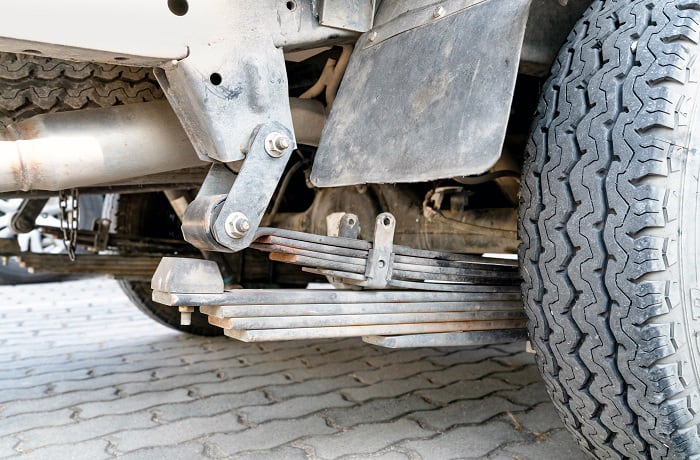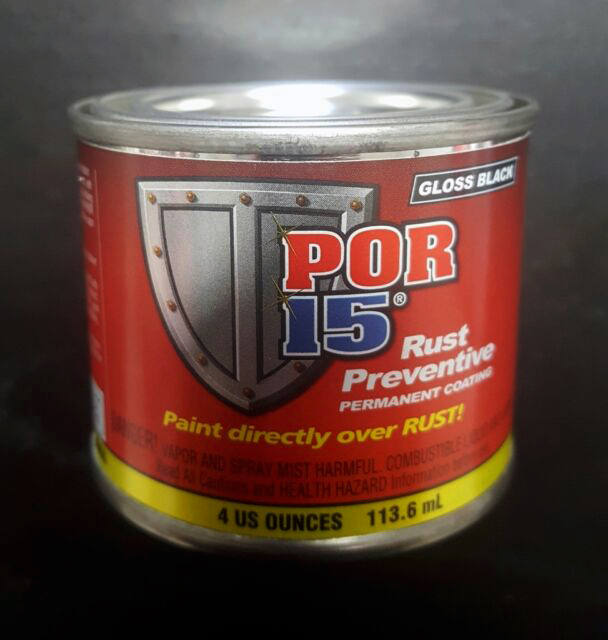Rust can be a relentless enemy, especially for the critical components of your vehicle’s suspension system, like leaf springs.
These components are particularly vulnerable in environments laden with moisture and road salt, which can accelerate the degradation and failure of metal parts.
Fortunately, a solution like POR-15, a high-performance rust-preventative coating, exists to offer a robust shield against such harsh conditions.
Designed to provide a rock-hard, non-porous finish that keeps moisture out, POR-15 ensures your leaf springs remain in top condition, extending their service life and maintaining vehicle safety and reliability.
This guide will walk you through applying POR-15 to leaf springs, ensuring you achieve the best protection against rust and corrosion.

Table of Contents
Preparation of Leaf Springs
1. Cleaning the Surface
Before applying POR-15, it’s essential to ensure that the leaf springs are thoroughly prepped. This involves a couple of critical steps:
Removing Rust and Scale
Start by removing any loose rust or flaking metal from the leaf springs. You can do this effectively using a wire brush or sandblasting, which is highly recommended for more extensive rust. This process provides a cleaner surface and enhances the adherence of the POR-15 to the metal.
Degreasing
Once the rust is removed, the next step is to clean off any grease, oil, or dirt residues that could prevent the paint from sticking. Use a degreaser or a solvent-based cleaner to clean the surface thoroughly. The leaf springs must be completely contaminant-free before moving to the next stage.
2. Applying Metal Prep
After cleaning, the leaf springs must be treated with a metal prep solution. This preparation is vital for a couple of reasons:
Etching the Metal
Metal prep solutions typically contain compounds that etch the metal surface, improving paint adhesion. The metal prep creates a rough surface that ensures POR-15 can bond more effectively with the leaf springs.
Timing and Rinsing
Apply the metal prep according to the manufacturer’s instructions, usually letting it sit on the metal for a specified period. After the treatment, rinse the leaf springs thoroughly with water to remove any residual prep solution and dry them thoroughly before painting.

Application of POR-15
1. Mixing POR-15
The initial step in the application process is properly preparing the POR-15 paint for use:
Stirring
It’s essential to stir the POR-15 thoroughly to ensure that all the pigments and ingredients are well-mixed. Avoid shaking the can, as this can introduce air bubbles into the paint, which might affect the finish.
2. Applying the First Coat
Applying POR-15 correctly is crucial for achieving optimal rust protection:
Brush Application
Use a paintbrush to apply a thin, even first coat of POR-15 to the leaf springs. A brush is preferable as it allows you to control the application precisely and ensures you reach into all the nooks and crannies of the springs, where rust is most likely to start.
Coverage
Make sure every part of the leaf springs is covered with the paint. The aim is to create a barrier that moisture cannot penetrate, so meticulous coverage is critical.
Drying Time
Allow the first coat to dry to the touch. Depending on the ambient temperature and humidity, this could take 2-6 hours. Ensure the coat is tacky before proceeding to the next step; this timing is vital for achieving the best results.
3. Applying the Second Coat
The durability of the POR-15 coating often depends on a successful second application:
Second Layer
Once the first coat is set but still tacky, apply a second coat of POR-15. This layer reinforces the protection, filling in any spots that might have been missed or thinly covered in the first application.
Curing Time
Allow the second coat to fully cure, which can take up to 48 hours. Full curing is necessary for the paint to achieve its legendary hardness and chemical resistance.
Aftercare and Maintenance
1. Curing Process
After applying POR-15, the proper curing of the coating is critical for achieving the maximum effectiveness of the product:
Full Curing Time
Allow the leaf springs to sit undisturbed and cure over several days. This period is crucial for the POR-15 to achieve its maximum hardness and protective properties. The curing time can vary, but a week is recommended for the coating to harden fully.
2. Reinstallation
Once the POR-15 has fully cured, you can move on to reinstalling the leaf springs:
Reinstallation
Carefully reinstall the treated leaf springs onto your vehicle. Ensure all connections are secure and the leaf springs are correctly positioned to function as expected in the vehicle’s suspension system.
3. Regular Inspection
Maintaining the integrity of the POR-15 coating over time is essential, especially under harsh conditions:
Inspection and Touch-Ups
Regularly inspect the condition of the coating on your leaf springs. Look for any chips, wear, or areas where moisture might penetrate. If there is any damage, apply a touch-up coat of POR-15 to maintain the protective barrier against rust.
Tips for Best Results
1. Avoiding Moisture
Ensuring the longevity and effectiveness of your POR-15 coating involves careful consideration of environmental factors:
Dry Application Conditions
Apply POR-15 in a dry environment. Humidity and moisture can compromise the coating’s adhesion and effectiveness, potentially leading to premature failure. Therefore, choose a dry day or a controlled environment for the application process.
2. UV Protection
Since POR-15 is not inherently UV stable, additional steps should be taken if the leaf springs are exposed to sunlight:
Top Coat Application
Apply a suitable top coat to protect the integrity of the POR-15 coating and prevent degradation from UV exposure. This top coat will shield the POR-15 from direct sunlight and prolong its protective properties.
Conclusion
Applying POR-15 to leaf springs is a straightforward yet essential process for preventing rust and extending the life of these crucial suspension components.
Following this guide’s surface preparation, application, and maintenance steps, you can protect your vehicle’s leaf springs against harsh conditions.
Remember to apply POR-15 in a moisture-free environment and consider additional UV protection if the springs are exposed to sunlight.
With these precautions and regular inspections, your leaf springs will remain in excellent condition, safeguarding your vehicle’s performance and safety.
